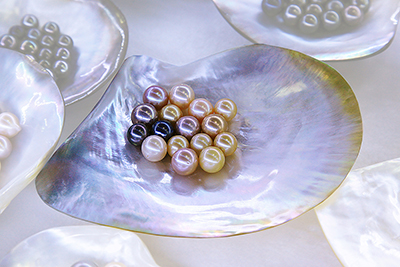Pearls are one of the most beloved precious materials in modern jewellery making. Both saltwater and freshwater pearls are set in precious metals and often with other precious gemstones to create beautiful fine jewellery that women love to wear and will treasure for generations to come.
When we think of pearls, we usually think of white and cream colored pearls. In reality, however, pearls come in a wide range of colors, from black and gray to gold and pink. In addition to the basic color of the pearl, the final result is also affected by the intensity and tone of the color. The color of pearls depends on the type of shell, while the intensity and tone of the color depend on the number of pearl layers and their thickness. Also, how the size of the pearl depends on the type of nacre.

White saltwater pearls usually come from either the shellfish Pinctada Fucata Martensii (Akoya pearls) in the seas of Japan, China, and Vietnam, or from Pinctada Maxima (South Sea pearls), in Australia, Indonesia, and the islands of the Philippines.
Black pearls come mainly from the Pinctada margaritifera, also known as the Black lip pearl oyster. Tahitian black pearls are the most well-known, but this particular type of shellfish is also found on coral reefs in several seas, from the Persian Gulf and the Indian Ocean to Australia, Japan, and French Polynesia.
Pink pearls come in several varieties of pearls, such as Akoya and South Sea. Their color can range from light pink, and peach to light lilac.
The rarest pink pearls, however, are the queen conch pearls of the Caribbean, which have an oval shape and a bright pink color. The queen conch oyster is one of the most delicate pearl-producing animals, and so far all attempts to produce cultured conch pearls have failed. Every year about 2000-3000 pink conch pearls are caught but of these a very small number, about 15-20 are of jewellery-making quality. This is why conch pearls are one of the rarest and most expensive varieties.
Let's start by saying that golden pearls are actually natural pearls. It is one of the rarest natural colors in pearls and shades range from champagne gold to a deep gold similar to that of 24 karat gold. They come from the gold-lipped South Sea pearl oysters Pinctada Maxima of the South Seas.
Natural silver or gray pearls come from two varieties of pearl oysters, the Pinctada Margaritifera, from which the Tahitian black pearls and the silver-lipped Pinctada Maxima of the South Seas also come.
It is one of the rarest pearl colors with a special iridescent color. It is derived from the black-lipped saltwater pearl oyster Pinctada margaritifera, i.e. Tahitian pearls. It is one of the rarest and at the same time sought-after varieties of pearls.